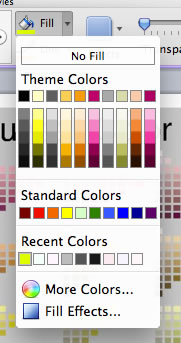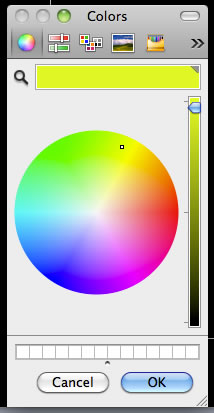Find presentation-quality images of the art/designs:
Get scans or digital photos with good detail/focus and accurate color representing the work you discuss. The more images the better! We want to see what you’re talking about.
JPG images are generally best. Max size for Powerpoint — ~1000(v) x 1200(h) pixels will fill the full screen. Larger size images are basically wasted — the resolution of the monitor/projector is too low to project more detail. In general, if you've created a JPG file larger than 250kb, it probably bigger in size, and finer in detail, than is necessary.Prepare a Powerpoint presentation with images of the artist/designer's work, textual introduction to the artist/designer and color samples and charts that analyze the color designs.
If you have no experience with PowerPoint speak with the instructor. The basics of PowerPoint are truly basic. As long as you have basic computer skills, you can learn the PowerPoint essentials in a short time. (Let's face it — Powerpoint is even easy enough for your teachers to use.)
Before you present...
File Formats
Confirm whether you will be presenting in class, or presenting online -- semester-specific requirements vary.
If Presenting In the Classroom directly (in person):
Be sure that you save your presentation in a file format that will run correctly on the computer that is in the classroom.— There are now some online alternatives to Powerpoint. While I still prefer you to turn in your presentation via a Powerpoint file, there are these options, briefly reviewed here.
Google Docs | SlideRocket (used successfully for this assignment) | Prezi | Zoho |
— You can also prepare presentations in OpenOffice Impress.
Open Office is a freeware project that competes directly with Microsoft Office products. Its available for both Mac and Windows (and probably Linux).
Impress info and download
Impress Export/SaveAs to Powerpoint (.ppt) format
HOWEVER, be SURE TO SAVE-AS TO A POWERPOINT (ppt) FILE BEFORE COMING TO CLASS.— If you're bringing a file to class, save your file as a Powerpoint .ppt file (this is a somewhat older file format)
OR as a PowerPoint .pptx file (this is the newest MS Powerpoint file format. )— DO NOT bring an Apple KeyNote or OpenOffice Impress presentation.
The software needed to display these files is not installed in our classroom.
As far as I know, you can "Save As" or "Export" from either of these programs to create a PowerPoint .ppt version of your presentation.
Convert your presentation while working on your computer, before your presentation day— we cannot convert file formats in our classroom. Grade penalties will be assessed if this is not taken care of prior to class period on presentation day.— DO NOT simply bring a folder full of .jpeg files. Organize your entire presentation in Powerpoint.
—If you have any questions about whether your presentation will display on the classroom computer, bring a sample file to class at least one class before you are to present. Stay after class and test the system — see if it works before presentation day.
Bring/Transfer your file to class
Plan to get your Powerpoint file to class by the most reliable means possible — bring it yourself on a USB memory key or on a CD. Be in the classroom about 10 minutes before the bell so we can transfer your file before class begins.
(Not ideal...but if you must...) You can also email it to the instructor — as long as a) he knows its coming and b) has time to transfer your file before class, and c) the file is not so huge that it chokes our email server. (there are attached-file-size limits. currently 5 mb.)
Font Incompatibility
Be aware that Powerpoint can only display fonts that are installed on the presenting computer.
What does that mean?
It means that you can create an absolutely gorgeous layout in Powerpoint using your favorite, most expressive and stylish font. But when you show your presentation in class, the fonts might be ugly and won't even fit on the page.
Why?
Because the computer in our classroom, does not (likely) have your fancy font installed. Thus, Powerpoint (in our classroom) can't find and display your beautiful, stylish font.
How can I work around that problem...
The simplest option is to use what are usually called "web-safe fonts". These are fonts that are typically installed on most computers — whether Mac or Windows.
But I really like my favorite font... what can I do?
Explore and use Powerpoint's Embed Font option, or Package for CD feature. (more Embed instructions) (more)
Keep it Simple
Narrow your topic down: Avoid topics that cannot realistically be covered during a short presentation.
For instance, "Impressionism" is far too vast for an 8 minute presentation. Premier colorist painters such as Monet and Van Gogh are too broad because they have such wide variety of color explorations during their careers. If you want to present such colorists, you'll need to narrow your topic down. Try Van Gogh's late landscapes or his early still lifes or his portraits — just don't try to cover it all!
Color Swatch your designer's palettes
Use Color Swatches to visually present palettes of colors used in the designs by the artist/designer you are presenting.
The newest version of PowerPoint no longer has the always handy "eyedropper" tool.
Which is a real pain for our purposes. However, there is a replacement.
a) Select the color swatch (square or other shape) that you want to color.
b) Open the "Fill" submenu (see below) using the down-arrow next to the Fill bucket icon/label ...
c) ..click on "More Colors..."
d) When the Hue-Brightness-Value color picker opens... see below...
...click on the Magnifying Glass icon near the upper left....
e) use the Magnifying Glass to find the color sample you want in the image you're presenting. When you've centered on the exact color you want, just Click!
That should do it! The selected shape (color swatch) should now be filled with the color that you clicked on.
If you're running Windows, this freeware utility may help: http://www.inetia.com/en/eyedropper/
other Windows options noted here... http://www.powerpointninja.com/toolbox/powerpoint-and-the-elusive-color-picker-eye-dropper/

